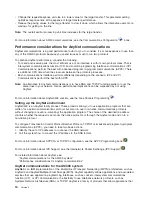
Chapter 3. Optimizing communications performance
Many factors can affect the performance of AS/400 application programs. To achieve the best performance
with your particular communications environment, you may want to review these topics:
v
Improving wide area network (WAN) performance.
v
Improving local area network (LAN) performance.
v
Improving data path performance.
Improving wide area network performance
To achieve better performance with your AS/400 when communicating in a wide area network (WAN), you
need to consider the following:
v
“Adjusting WAN protocols for optimum AS/400 performance”
v
“Adjusting the WAN line speed for optimum AS/400 performance”
v
“WAN line speed considerations for IOPs” on page 8
Adjusting WAN protocols for optimum AS/400 performance
Wide area network (WAN) protocols affect the communications performance on AS/400. Let us use X.25
for our example. For each X.25 communications controller, the AS/400 has some processing limitation for
the line, the line speed, and the total number of virtual circuits that can be used. Performance degradation
can be reduced by observing these limitations.
To optimize AS/400 performance for wide area networks, perform these tasks:
v
Reduce the total number of frames by using larger frames.
v
To take advantage of these large frame sizes, change the MAXFRAME parameter on the line
description (LIND) to reflect the maximum value. For X.25, increase the DFTPKTSIZE and MAXFRAME
parameters to their maximum value.
v
Configure a WAN line as full-duplex to provide you with a higher throughput for applications that can
take advantage of this mode. This can also provide higher throughput for multiple users.
v
Increase frame relay to capacity.
The data rate for a given protocol may increase as frame size increases. Under these circumstances, the
central processing unit (CPU) and the input/output processor (IOP) do not do as much processing. Fewer
and larger frames also make more efficient use of the communications line (higher effective data rate)
because of fewer overhead bytes and line turn-arounds.
Frame relay has equivalent performance over RS449, X.21, and V.35 assuming equal line speeds and
conditions. Frame relay performance (CPU time) is similar to or slightly better than Synchronous Data Link
Control. For properly tuned large transfer applications, the CPU and IOP have no problem using the line
speed to capacity.
For information about configuring AS/400 communications, see the Communications Configuration
book.
Adjusting the WAN line speed for optimum AS/400 performance
In many cases, the communications line is the largest contributor to overall response time in the wide area
network (WAN). Therefore, you should closely plan and manage its performance. In general, having the
appropriate line speed is the key consideration for gaining the best performance.
To adjust the line speed for your wide area network, perform these tasks:
v
Check the difference in performance between half-duplex utilization and full-duplex utilization on the line
description.
© Copyright IBM Corp. 1998, 2001
7
Summary of Contents for AS/400
Page 1: ...iSeries Networking iSeries Communications Management ERserver...
Page 2: ......
Page 3: ...iSeries Networking iSeries Communications Management ERserver...
Page 8: ...2 Version 5...
Page 10: ...4 Version 5...
Page 12: ...6 Version 5...
Page 22: ...For more information about creating subsystems see the Work Management book 16 Version 5...
Page 26: ...20 Version 5...
Page 34: ...Example 3 AS 400 system for DLUR support with the host system 28 Version 5...
Page 36: ...30 Version 5...
Page 46: ...40 Version 5...
Page 57: ...Chapter 7 Communicating with remote workstation controllers 51...
Page 63: ...Chapter 7 Communicating with remote workstation controllers 57...
Page 82: ...Example 2 AS 400 to 4690 PEER connection over token ring network 76 Version 5...
Page 83: ...Chapter 7 Communicating with remote workstation controllers 77...
Page 84: ...78 Version 5...
Page 102: ...96 Version 5...
Page 103: ......
Page 104: ...Printed in U S A...














































